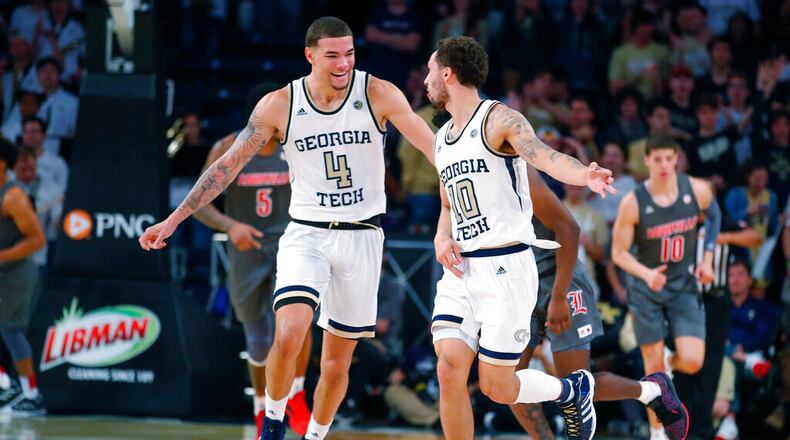After three months away from campus, many Georgia Tech athletes will be able to return Monday for voluntary workouts under the supervision of their team’s strength coaches.
Those on the men’s basketball team and on all Yellow Jackets teams, can brace themselves for something entirely moderate. Men’s basketball strength-and-conditioning coach Dan Taylor will have his players judge their effort in their hour-long workouts on a 1-10 scale of what’s known as an RPE scale, which stands for rate of perceived exhaustion.
“And I want the first two weeks, that perceived number, to be low, like lower than five,” he told the AJC. “Just nice and easy. Not easy, like just walking through, but just easy, like I’m not leaving here exhausted.”
Taylor’s strategy for a milder exercise plan follows the plan for all Tech athletes as the athletic department begins the first phase of its voluntary workout program. After suspending athletic activities in mid-March because of the coronavirus pandemic, the NCAA voted to allow schools to resume on-campus voluntary workouts starting June 1.
In Tech’s Phase 1, only returning Tech athletes living in metro Atlanta are eligible to participate.
Cardiovascular activity is being restricted in Phase 1 in part because there is an unknown risk for cardiac complications people to engage in high-intensity exercise who have contracted COVID-19 but are asymptomatic. Athletes will be tested upon arrival, and the athletic department will conduct surveillance testing and testing on athletes and staff who are symptomatic, athletic director Todd Stansbury said recently.
The basketball workout plan “is basically dictated by CDC rules and what the school’s expectations are and state and local government,” Taylor said.
As the phases advance, likely with more athletes permitted back and more exercise options available, Taylor expects to be able to ease up on the reins. But he initially will face the challenge of bridling elite athletes who have been away from teammates and organized workouts since mid-March.
“The guys will be a little bit of a pain with it because they’re going to want to put their foot on the gas because it’s their nature to,” Taylor said.
Taylor expects to have six Jackets returnees back on campus – guards Jose Alvarado, Michael Devoe, Bubba Parham and Jordan Usher and forwards David Didenko and Khalid Moore. Not all are local, but those who aren’t have remained in Atlanta.
Forward Moses Wright is at home in Raleigh, N.C. Taylor made the call to hold off on bringing back the walk-on players who live locally to minimize the number of participants for health-safety reasons. The two transfers, guard Kyle Sturdivant and forward Rodney Howard, while both in the Atlanta area, are not eligible to be part of the first phase as they are not returnees.
“I made the decision, in talking to (team trainer Richard Stewart). I said, ‘Look, I love those (walk-on) guys, but let’s just focus on the six,’” Taylor said.
Since campus closed, Taylor said that he has been designing workout plans for players and offering advice, but acknowledged he won’t know for sure how much players have worked out until they return. He joked that it’s possible they’ve been “playing Fortnite and sitting on the couch. That could be the reality, but I think we have enough age, experience and understanding of where we’re at, program-wise, that they’re not going to do that.”
Coach Josh Pastner said that he hasn’t asked players about whether they’ve been able to work on their games or stay in shape.
“My No. 1 thing I’m checking on is their health and wellness, both physically and mentally, and making sure they’re staying on top of their academics,” Pastner told the AJC. “Whenever we are allowed to be cleared to have on-court skill instruction, that’s when I’ll move on to that phase.”
Taylor paraphrased Pastner’s approach as, “I just want to make sure the family is good. The rest of it we’ll just figure out.”
Athletes will have six one-hour workouts in the first two weeks of Phase 1, three each week. In the hour, Taylor’s plan is to put players through 25 different exercises, doing 20 repetitions of each, along with warm-up, cool down and a few exercises specifically designed for each player.
They will consist of a range of movements and lifts, such as planks, dumbbell bench press and trap-bar dead lift. They were selected in part with social distancing in mind.
“Me spotting the guys doing a 400-pound squat, really tight to their bodies, is not a good idea weeks one and two,” Taylor said.
Taylor will be in the weight room at the Zelnak Basketball Center with Stewart and no more than four players at a time. Everyone will be masked, Taylor said.
“It’s just super simple,” Taylor said. “You get 25 exercises, which also includes some core stuff and some body-weight stuff, and we’re going to start here, and obviously I’ll set it up beforehand, so it’ll almost be like a production line, A to B to C to D and so on.”
Another reason for putting players through a moderate workout initially is that he isn’t sure how intensely they’ve worked out on their own. He compared it with the workouts that a player might go through when coming back from an injury.
A spike in workout load, Taylor said, could lead to injuries down the road.
With much on the line in the season to come – Tech is aiming for its first NCAA tournament berth since 2010 – not overdoing it would seem the wise course.
About the Author





